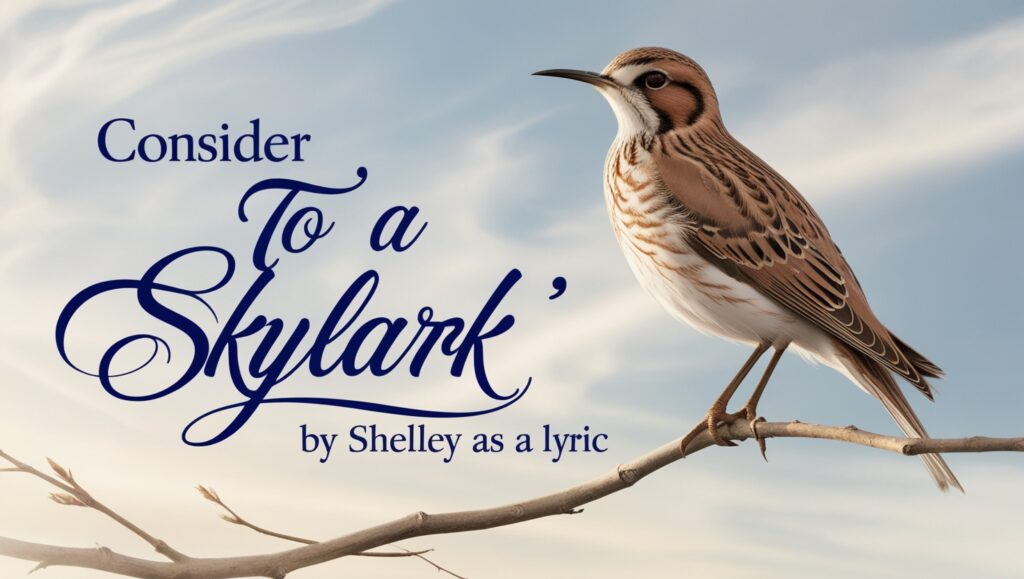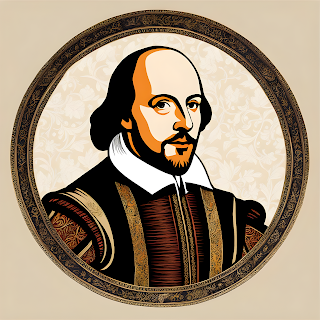
Consider To a Skylark by Shelley as a Lyric
Percy Bysshe Shelley’s To a Skylark is widely regarded as one of the most outstanding examples of lyric poetry in English literature. A lyric poem is traditionally short, highly personal, and primarily concerned with expressing the emotions or thoughts of the speaker. It typically emphasizes musicality and personal subjectivity, often dealing with themes of nature, love, or individual experience. To a Skylark exemplifies these characteristics, offering readers an emotional, reflective, and meditative exploration of the skylark’s joyous song as a metaphor for an ideal state of existence. Shelley, in this poem, creates a beautiful fusion of philosophical depth and aesthetic grace, presenting the skylark as a symbol of transcendent joy and spiritual freedom.
This analysis will examine how To a Skylark fits the conventions of lyric poetry, focusing on its personal voice, emotional intensity, musical quality, vivid imagery, and thematic exploration of joy and inspiration.
Personal Voice and Direct Address
One of the hallmarks of lyric poetry is the presence of a personal voice, and To a Skylark is a deeply personal poem in which the speaker directly addresses the skylark in a tone of wonder and admiration. From the opening line, Shelley establishes an intimate connection between the speaker and the bird:
“Hail to thee, blithe Spirit!
Bird thou never wert—”
The use of the word “thee” signals a personal and direct address to the bird, suggesting that the speaker is not merely observing the skylark from a distance but is engaged in an emotional and intellectual dialogue with it. Throughout the poem, Shelley’s speaker continuously addresses the skylark in second-person, expressing a desire to understand and learn from its state of perfect joy.
The skylark becomes more than just a bird; it becomes a representation of something beyond the speaker’s reach—a symbol of pure, untethered joy, spiritual freedom, and creative inspiration. By framing the poem as a direct conversation with the skylark, Shelley imbues the poem with a sense of immediacy and intimacy, qualities that are central to lyric poetry.
Emotional Intensity and Subjectivity
Another defining feature of lyric poetry is its focus on emotion and subjectivity. To a Skylark is suffused with intense emotions as the speaker reflects on the skylark’s ability to express boundless joy and freedom. The poem contrasts the skylark’s ideal existence with the limitations and sorrows of human life, creating a tension between the joy represented by the bird and the speaker’s own yearning for such joy.
The speaker’s admiration for the skylark’s song becomes an expression of his own longing for transcendence, as he contemplates the distance between the bird’s perfect happiness and the imperfection of human existence. Shelley writes:
“What thou art we know not;
What is most like thee?”
These lines reflect the speaker’s sense of wonder and frustration—he can hear the skylark’s song, but he cannot fully comprehend or share in its joy. The skylark’s experience remains beyond human understanding, and this awareness of limitation evokes a deep emotional response from the speaker. The bird’s song becomes a metaphor for the unattainable ideal, a state of existence that the speaker longs for but can never fully achieve.
This emotional intensity is characteristic of lyric poetry, where personal feelings, desires, and thoughts are central to the poem’s thematic exploration. Shelley’s speaker does not merely describe the skylark; he engages emotionally with the bird’s song, using it as a lens through which to reflect on the human condition and the nature of joy.
Musicality and Rhythm
Musicality is a core element of lyric poetry, and Shelley’s To a Skylark is deeply musical in both form and content. The subject matter itself—the skylark’s melodious song—naturally lends the poem a musical quality, and Shelley’s use of rhythm, rhyme, and meter enhances this effect.
The poem consists of 21 five-line stanzas with a consistent rhyme scheme (ABABB). This regularity in rhyme gives the poem a song-like quality, echoing the bird’s continuous and harmonious song. Additionally, Shelley employs trochaic meter (a stressed syllable followed by an unstressed syllable), which creates a rhythmic, flowing effect that mimics the rise and fall of the skylark’s flight and song. The use of enjambment, where lines flow into each other without pause, further contributes to the sense of movement and fluidity, much like the bird’s soaring ascent into the sky.
For example:
“Higher still and higher
From the earth thou springest,
Like a cloud of fire;
The blue deep thou wingest,
And singing still dost soar, and soaring ever singest.”
The repeated use of participles like “soaring” and “singing” emphasizes the continuous, uninterrupted nature of the skylark’s song, giving the poem a dynamic, uplifting rhythm. This musicality is essential to the poem’s lyricism, as it mirrors the very subject of the poem—the skylark’s joyful song—and elevates the poem’s emotional and aesthetic impact.
Vivid Imagery and Nature
Lyric poetry often relies on vivid, evocative imagery to convey emotional depth and meaning, and To a Skylark is rich in such imagery, particularly related to the natural world. Shelley compares the skylark to various natural phenomena, emphasizing its ethereal beauty and the awe it inspires:
“Like a poet hidden
In the light of thought,
Singing hymns unbidden,
Till the world is wrought
To sympathy with hopes and fears it heeded not.”
In this comparison, the skylark is likened to a poet, suggesting that the bird’s song is an expression of spontaneous, unpremeditated art. This metaphor not only elevates the skylark to the realm of artistic and creative inspiration but also aligns the bird’s song with the poet’s desire to create beauty through verse. Other comparisons, such as the skylark being “Like a rose embowered” or a “glow-worm golden,” further highlight the bird’s connection to nature, emphasizing its delicate, radiant beauty.
Shelley’s use of imagery connects the skylark to larger forces of nature, including the sun, sky, clouds, and fire, creating a sense of vastness and transcendence. The skylark is not just a creature of the earth; it becomes a symbol of something greater, something sublime and infinite.
This connection between nature and transcendence is a common theme in lyric poetry, where personal emotion is often tied to reflections on the natural world. In To a Skylark, Shelley uses nature not only to describe the skylark’s beauty but also to explore philosophical ideas about joy, creativity, and the human longing for something beyond the ordinary.
Exploration of Universal Themes: Joy, Creativity, and Human Limitations
While To a Skylark is deeply personal in its emotional expression, it also touches on universal themes that resonate with readers beyond the immediate context of the poem. One of the central themes of the poem is the nature of joy and its relationship to human experience. The skylark’s song is a perfect expression of joy, free from the sorrows, fears, and regrets that define human life. Shelley writes:
“We look before and after,
And pine for what is not:
Our sincerest laughter
With some pain is fraught;
Our sweetest songs are those that tell of saddest thought.”
In these lines, Shelley contrasts the skylark’s untroubled joy with the complexity of human emotion. Humans, unlike the skylark, are burdened by memory and anticipation, constantly looking back on the past or worrying about the future. Even in moments of happiness, humans are aware of the possibility of loss or sorrow, and this awareness taints their experience of joy.
This exploration of the limits of human happiness is a key theme in the poem, and it underscores the speaker’s desire to learn from the skylark’s ability to experience pure, unblemished joy. The skylark’s song becomes a symbol of artistic inspiration and creative freedom, qualities that the speaker longs to capture in his own poetry. By expressing this longing, Shelley reflects on the nature of creativity itself—while the skylark’s song is spontaneous and effortless, human art is often laborious and tinged with sorrow.
This philosophical depth, combined with the personal emotion of the speaker, makes To a Skylark a quintessential lyric poem. It is not just a celebration of the bird’s song but a meditation on the human condition, the nature of joy, and the power of art.
Conclusion
P.B. Shelley’s To a Skylark stands as a masterful example of lyric poetry, embodying all the qualities that define the form. Through its personal voice, emotional intensity, musicality, vivid imagery, and exploration of universal themes, the poem captures the essence of lyricism—an intimate expression of the speaker’s thoughts and feelings in response to the natural world.
The skylark, in Shelley’s hands, becomes more than just a bird; it becomes a symbol of transcendent joy, creative freedom, and the human longing for an ideal state of existence. The poem’s rich musicality and rhythmic flow mirror the bird’s continuous song, while its vivid imagery connects the skylark to the vast, sublime forces of nature.
Ultimately, To a Skylark is a deeply philosophical and emotional reflection on the power of art, the nature of happiness, and the limitations of human experience, making it one of the most enduring and beloved lyric poems in the English language.

